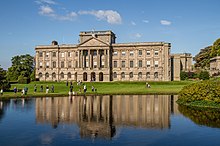Lyme Hall
| Lyme Park | |
|---|---|

The south front of the mansion house, showing the south lawn and the pond
|
|
| Location | Disley, Cheshire, England |
| Coordinates | 53°20′17″N 2°03′17″W / 53.3381°N 2.0548°WCoordinates: 53°20′17″N 2°03′17″W / 53.3381°N 2.0548°W |
| OS grid reference | SJ 964 823 |
| Built | 16th century, 1720s |
| Architect | Giacomo Leoni |
| Architectural style(s) | Elizabethan, Palladian, Baroque |
|
Listed Building – Grade I
|
|
| Designated | 17 November 1983 |
| Reference no. | 406869 |
Lyme Park is a large estate located south of Disley, Cheshire. The estate is managed by the National Trust and consists of a mansion house surrounded by formal gardens, in a deer park in the Peak District National Park. The house is the largest in Cheshire, and is recorded in the National Heritage List for England as a designated Grade I listed building.
The estate was granted to Sir Thomas Danyers in 1346 and passed to the Leghs of Lyme by marriage in 1388. It remained in the possession of the Legh family until 1946 when it was given to the National Trust. The house dates from the latter part of the 16th century. Modifications were made to it in the 1720s by Giacomo Leoni, who retained some of the Elizabethan features and added others, particularly the courtyard and the south range. It is difficult to classify Leoni's work at Lyme, as it contains elements of both Palladian and Baroque styles. Further modifications were made by Lewis Wyatt in the 19th century, especially to the interior. Formal gardens were created and developed in the late 19th and early 20th centuries. The house, gardens and park have been used as locations for filming and they are open to the public. The Lyme Caxton Missal is on display in the Library.
The land now occupied by Lyme Park was granted to Piers Legh and his wife Margaret D'anyers, by letters patent dated January 4, 1398, by Richard II, son of the Black Prince. Margaret D'anyers' grandfather, Sir Thomas D'anyers, had taken part in retrieving the standard of the Black Prince at the Battle of Crécy in 1346, and was rewarded with annuity of 40 marks a year by the Black Prince, drawn on his Cheshire estate, and which could be exchanged for land of that value belonging to the Black Prince. Sir Thomas died in 1354, and the annuity passed to his nearest surviving kin, his granddaughter Margaret, who in 1388 married the first Piers Legh (Piers Legh I). Richard II favoured Piers and granted his family a coat of arms in 1397, and the estate of Lyme Handley in 1398 redeeming the annuity. However, Piers was executed two years later by Richard's rival for the throne, Henry Bolingbroke.
...
Wikipedia

